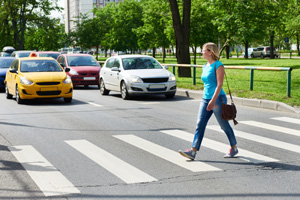
Pedestrians can bear responsibility for accidents in Texas under specific circumstances. While many assume that drivers are always at fault, pedestrians can also act negligently and contribute to collisions. Understanding these legal standards helps both drivers and pedestrians take appropriate precautions.
At Byrd Davis Alden & Henrichson,l LLP, our experienced legal team understands the nuances of Texas accident laws. We are dedicated to helping our clients build strong cases, whether they are drivers or pedestrians. If you’ve been involved in an accident, it’s essential to consult with a knowledgeable attorney who can assess your situation, advise you on your rights, and help you seek the compensation you deserve.
Laws Defining Pedestrian Liability in Texas
Texas law requires both drivers and pedestrians to exercise caution to prevent accidents. Pedestrians must obey traffic signals, use designated crosswalks, and avoid reckless behavior. Violating these rules can establish negligence, making pedestrians responsible for damages caused by their actions. Courts assess each accident based on these legal principles to determine liability.
Texas follows a modified comparative fault system, assigning fault percentages to all parties involved. If a pedestrian shares responsibility for an accident, their ability to recover damages decreases based on their percentage of fault. When found more than 50% responsible, pedestrians cannot collect compensation. Your lawyer will be able to work with you to get a better idea of shared fault and how it applies to your specific case.
When Pedestrians Cause Accidents
Pedestrians contribute to accidents when they act carelessly. Stepping into traffic without warning, ignoring signals, or crossing outside designated areas increases the likelihood of collisions. Walking while distracted or under the influence of alcohol further raises the risk.
Reckless behavior, such as running across busy streets, forces drivers into dangerous maneuvers. Pedestrians who ignore traffic laws jeopardize their safety and may bear legal responsibility for resulting accidents.
Common Situations Where Pedestrians Share Fault
Certain behaviors place pedestrians at risk of liability. Jaywalking remains a frequent cause of accidents, especially when pedestrians cross in high-traffic areas without regard for oncoming vehicles. Ignoring traffic lights also contributes to collisions, as drivers expect pedestrians to follow the law.
Pedestrians who fail to check for approaching vehicles before crossing create hazardous conditions. Walking along highways or stepping off sidewalks unexpectedly further increases the risk. These actions can result in shared fault assessments, limiting compensation options.
Evidence Used to Prove Pedestrian Fault
Multiple forms of evidence determine fault in pedestrian accidents. Witness statements provide valuable perspectives on the events leading to a collision. Surveillance footage and traffic camera recordings offer visual proof of pedestrian behavior before impact.
Police reports document critical details, including statements from both parties and initial fault assessments. Physical evidence, such as skid marks or damaged vehicle parts, helps reconstruct accident dynamics. Insurance companies rely on these findings to determine liability and adjust compensation amounts.
Texas Comparative Fault Laws and Compensation
Texas law reduces compensation based on a person’s degree of fault. If a pedestrian bears partial responsibility for an accident, their compensation decreases proportionally. For example, a pedestrian found 30% responsible would receive 70% of the awarded damages.
Pedestrians found more than 50% at fault cannot recover compensation. This legal standard ensures fair accountability and prevents those responsible for accidents from benefiting financially. Drivers and pedestrians should understand these rules when pursuing claims.
Legal Options for Drivers Hurt by Negligent Pedestrians
Drivers injured due to pedestrian negligence have legal recourse. If a pedestrian causes an accident, drivers may seek damages to cover medical expenses, lost income, and other financial losses. Evidence collected from the scene strengthens claims in legal proceedings.
Working with an experienced attorney increases the likelihood of securing fair compensation. Lawyers analyze evidence, negotiate with insurance providers, and present strong arguments in court if necessary. Protecting legal rights in these cases requires thorough documentation and skilled representation.
How Legal Representation Helps in Pedestrian Accident Cases
Attorneys play a key role in pedestrian accident claims by gathering critical evidence, consulting expert witnesses, and interpreting relevant laws. Legal professionals ensure fair evaluations of fault and advocate for their clients’ best interests.
Insurance companies may attempt to shift blame or minimize payouts. Skilled attorneys counter these tactics by presenting clear evidence and negotiating aggressively. Seeking legal counsel improves the chances of securing appropriate compensation.
Contact Byrd Davis Alden & Henrichson, LLP for Legal Support
Accidents involving pedestrians require thorough legal analysis to determine fault and secure fair compensation. Whether you are a driver injured by a pedestrian’s negligence or a pedestrian facing liability concerns, legal guidance ensures a fair process.
At Byrd Davis Alden & Henrichson, LLP, we provide experienced representation in pedestrian accident cases. Contact us today to discuss your situation and explore your legal options. Contact Byrd Davis Alden & Henrichson, LLP at (512) 489-9477 or use our contact form.

